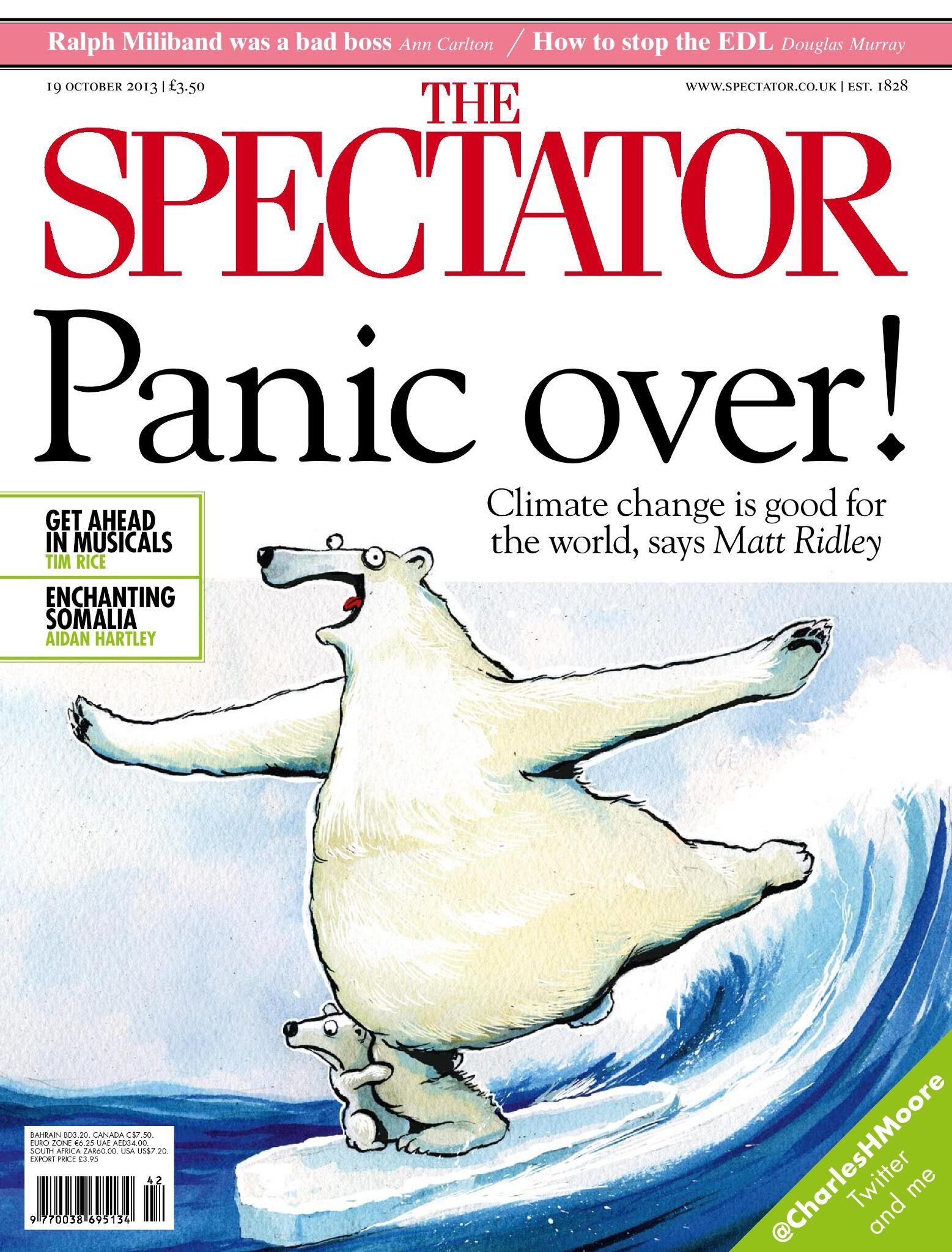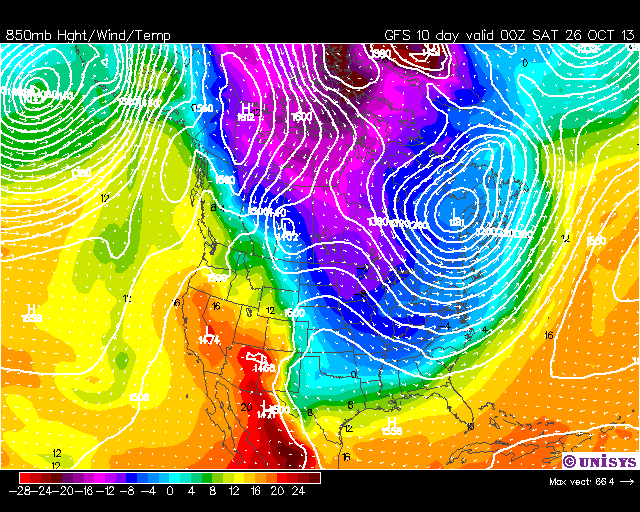Report: U.S. becomes world’s largest producer of oil in 2013
…Yale Professor ‘Embarrassed’ to Discover Tea Party Members are Scientifically Literate
Yale Professor ‘Embarrassed’ to Discover Tea Party Members are Scientifically Literate | CNS News
Matt Ridley: ‘Don’t Panic’ — ‘Why climate change is good for the world’ – ‘Warmer temperatures do more good than harm’

The chief benefits of global warming include: fewer winter deaths; lower energy costs; better agricultural yields; probably fewer droughts; maybe richer biodiversity. It is a little-known fact that winter deaths exceed summer deaths — not just in countries like Britain but also those with very warm summers, including Greece. Both Britain and Greece see mortality rates rise by 18 per cent each winter. Especially cold winters cause a rise in heart failures far greater than the rise in deaths during heatwaves.
Cold, not the heat, is the biggest killer.
…
In fact, the death rate from droughts, floods and storms has dropped by 98 per cent since the 1920s, according to a careful study by the independent scholar Indur Goklany. Not because weather has become less dangerous but because people have gained better protection as they got richer: witness the remarkable success of cyclone warnings in India last week. That’s the thing about climate change — we will probably pocket the benefits and mitigate at least some of the harm by adapting. For example, experts now agree that malaria will continue its rapid worldwide decline whatever the climate does.
…
As Bjorn Lomborg has pointed out, the European Union will pay £165 billion for its current climate policies each and every year for the next 87 years. Britain’s climate policies — subsidising windmills, wood-burners, anaerobic digesters, electric vehicles and all the rest — is due to cost us £1.8 trillion over the course of this century. In exchange for that Brobdingnagian sum, we hope to lower the air temperature by about 0.005˚C — which will be undetectable by normal thermometers. The accepted consensus among economists is that every £100 spent fighting climate change brings £3 of benefit.
So we are doing real harm now to impede a change that will produce net benefits for 70 years. That’s like having radiotherapy because you are feeling too well. I just don’t share the certainty of so many in the green establishment that it’s worth it. It may be, but it may not.
…
New Website: FakeNobelLaureates.com – ‘Thousands of news articles, interviews, videos, and photos had mistakenly described the IPCC’s chairman, Rajendra Pachauri, and numerous other IPCC-linked individuals as nobelists. Correcting the record is an enormous task’
…Fake Nobel Laureates & the White House: ‘What happens to people who claim to be Peace Prize winners even though they aren’t? They get a job at the White House.’
‘This, my friends, is the problem with the climate scare. Once you start looking closely, you discover that too many of the actors involved are the furthest thing from careful, rigorous thinkers. Instead, they appear small, grasping, and shabby. And they never seem to face any adverse consequences. Instead, they get invited to the White House – either as guests or as employees.’…
Gore’s Climate Reality Project is set to do another 24 hour of alternate reality – nobody cares
Gore’s Climate Reality Project is set to do another 24 hour of alternate reality – nobody cares
This year, they are bringing in a comedian (no relation): Carbon pollution is not only disrupting our lives, it’s hitting our wallets. Comedian and musician Reggie Watts shows how, laying out the billion-dollar connection between fossil-fuel energy and dirty weather events like Superstorm Sandy caused by carbon pollution. I guess he didn’t read the recent […]
Sent by gReader Pro…
The Polar Express is Leaving the Station: ‘Major cold air outbreak for most of the U.S. late next week’
(Follow Climate Depot on Twitter)
Via Climatologist Dr. Roy Spencer: The Polar Express is Leaving the Station
http://www.drroyspencer.com/2013/10/the-polar-express-is-leaving-the-station/
I’ve been watching the 10-day GFS forecast for the U.S., and each run is reinforcing the previous one, with a major cold air outbreak for most of the U.S. late next week:

I’m reminded of when I started the graduate program in meteorology at UW-Madison in the fall of 1978. We were getting an unusual string of cold fronts which all the professors were claiming could not last. Eventually, warmer Pacific air would come in from the west…it always does.
Except during winter ’78-’79…it didn’t. The cold air just kept coming.
I’m not making a winter forecast here…just reminiscing. But I will say that I’ve been watching the model forecasts nearly every day for decades (since I’m co-developer of WeatherStreet.com, and still a weather weenie at heart), and for many years the model forecast tendency has been to over-forecast these cold air outbreaks.
The model would predict a cold front coming through our neck of the woods (N. Alabama) 5-7 days in advance…but the front would almost never make it, or it would not plunge as far south (or be as cold) as originally forecast.
But this model error tendency seems to have changed in the last couple years, with that cold air not only making it, but reaching the Gulf coast and beyond. This has been a record cold summer in Alabama, and we had cool fronts pass through regularly all summer long. I don’t recall that ever happening in the 30 years we have lived here. The lawn stayed spring-green all summer, when usually we have to work to keep it alive.
Maybe my friend Joe Bastardi will chime in and say whether he has seen a similar change in the model error in recent years.
At least we can be thankful that when the cold air does arrive, it will be slightly warmer than it would have been without global warming. Ha-ha.
Related Links:
Early Winter: Alaska – Shortest Summer On Record — Winter Storm for the West – Earliest ever …
An unbiased economic score card shows Global Warming has increased the GDP by 1.3% so far
An unbiased economic score card shows Global Warming has increased the GDP by 1.3% so far
http://www.freerepublic.com/focus/f-news/3079751/posts
How Much have Global Problems Cost the World? A Scorecard from 1900 to 2050 was editted by Bjørn Lomborg with many contributors They use an unbiased or at least a consistent methodology to assess the impact of global problems from 1900 to today and project forward to 2050. There are often blanket claims that the world is facing more problems than ever but there is a lack of empirical data to show where things have deteriorated or in fact improved. In this book, some of the world’s leading economists discuss ten problems that have blighted human development, ranging from malnutrition,…
Sent by gReader Pro…
Climatology Sees One Of The Greatest Scientific Reversals Of All Time – The Rise And Fall Of The Hockey Stick Charts
Climatology Sees One Of The Greatest Scientific Reversals Of All Time – The Rise And Fall Of The Hockey Stick Charts
The Rise And Fall Of The Hockey Stick Charts
By Michael Krüger, Science Skeptical Blog
(Translated, condensed, edited by P Gosselin)
The Intergovernmental Panel on Climate Change (IPCC) was created in November 1988 by the United Nations Environment Program (UNEP) and the World Organization for Meteorology (WMO). The main task of the UN Climate Framework Convention (UNFCCC) was to assess the risks of global warming and to draw up mitigation strategies. One important role was to determine the global climate development over the last 1000 years in order to see if the warming of the last century was “unique” and to see if today’s supposed manmade warming was a threat.
An examination of the five IPCC reports published thus far reveals a remarkable scientific reversal. What follows is the evolution of the 1000-year temperature curve: from double hump – to hockey stick – and back again to double hump.
1st Assessment Report, 1990
In the First Assessment Report of 1990, page 202 depicts the following chart:
Figure 1: Page 202 of the IPCC FAR.
In Figure 1 we see that the period of the 11th to 13th century, the Medieval Warm Period, was considerably warmer than today. The above graphic appears to be based on the publication from LAMB from 1965, H. H. LAMB, 1965, THE EARLY MEDIEVAL WARM EPOCH AND ITS SEQUEL Palaeogeography, Palaeoclimatology, Palaeoecology. The climate data were taken from Central England and extend up to 1970.
2nd Assessment Report, 1995
But already in the Second Assessment Report of 1995 the curve looks much different. On page 174:
Figure 2: Page 174 of the Second Assessment Report
But instead of showing the last 1000 years, as the section title states, the chart starts only in the 15th century, i.e. exactly at the end of the Medieval Warm Period. And there’s another oddity that stands out: The drawn mean curve does not match the depicted temperature curve.
3rdAssessment Report, 2001
In the Third Assessment Report of 2001 the following curve was presented by the IPCC (as to Mann, M.E, R.S. Bradley and M.K. Hughes (1998) Global-scale temperature patterns and climate forcing over the past six centuries.- NATURE, VOL 392, 23 April). In the literature often cited under (Michael E. Mann and Raymond S. Bradley (1999). Northern Hemisphere …
$22 billion wasted on carbon capture which increases cost of electricity by 70%
$22 billion wasted on carbon capture which increases cost of electricity by 70%
Three things everyone needs to know about carbon capture. Coal supplies 29% of the worlds total energy (and oil supplies 31%). In the last five years governments world-wide promised to spend $22 billion on carbon capture and storage (CCS). $5b in the US. CCS increases the cost of electricity by 70%. (Yes, you read that correctly, seventy percent). That’s about $60/ton of carbon reduction. TonyfromOz has been sending me gobsmacking details and statistics on this bizarre practice for months, and I must post them in their full glory as soon as possible. Historians of the future will gape at this strange religious ritual and ask how much we gave up in order to stuff a plant fertilizer down a deep hole in an effort to change the weather. – Jo —————————————————— Carbon capture and storage—the Edsel of energy policies … By Steve Goreham Originally published in The Washington Times The war on climate change has produced many dubious “innovations.” Intermittent wind and solar energy sources, carbon markets that buy and sell “hot air,” and biofuels that burn food as we drive are just a few examples. But carbon capture and storage is the Edsel of energy policies. […]Rating: 0.0/10 (0 votes cast)
Sent by gReader Pro…
